Every traveler should be prepared to do at least a little laundry before s/he reaches the end of the road.
Whether you’re a parent traveling with kids, a business traveler with a financial motive to look sharp, or an autoimmune sufferer like me whose arthritis causes you to unexpectedly fling things you’re attempting to hold in your weakened hands, a few minutes of immediate care can save a garment from destruction or at least degradation.
I have a few go to solutions for washing clothing away from my laundry room. It’s rare for me to leave home for even a single night without packing something I could use to attack a stain or wash out a pair of favorite socks to re-wear because they are the only ones that don’t seem unbearable in the moment.
Re-usable containers make every product travel sized
First, for anyone who keeps a cabinet full of reusable containers for lunches and leftovers, I respectfully submit that you can make your own travel size out of any preferred product. I think this is easily forgotten in our era of single serve options and packaging excess. Years ago, I bought single use packets of Woolite for travel because it simply never occurred to me to do anything different.
Obviously, one ought not put toxic chemicals into the same container used for food or drink. Either keep a dedicated set of bottles for cleaning supplies only, or, ideally, use non-toxic products to wash your clothes.
Those of us who deal with extreme sensitivities to fragrance or irritating contact dermatitis learn quickly that it can be uncomfortable or even dangerous to rely on products available in laundromats, at vacation rentals, or in friends’ homes.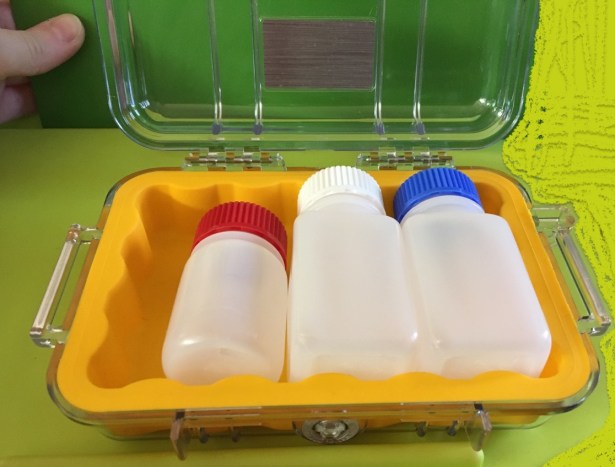
Nalgene bottles are dishwasher safe and can transport virtually any liquid used in the home. They’re pretty common in labs, too. I like to buy mine at REI because I’m a co-op member, but that sporting good store’s selection has narrowed of late probably due to pandemic supply chain issues.
The Container Store is another fine option for buying travel size bottles, especially if you live near one of these expensive but high service shops. I love that TCS has always offered curbside pickup service. For individual Nalgene bottles, their prices are competitive, but your eyes will water the first time you shop for closet organization accessories here.
Ranging from 1/2 oz up to 32 oz, Nalgene bottles run between $1.39 and $3.99 at The Container Store, the same as or similar to prices in sporting goods stores. I very much prefer the wide mouth version—shown below in its smallest size full of my SensiClean detergent—because they are easier to clean, but the narrow neck bottles are a usually few cents cheaper.
10¢ per bottle for the bigger opening is well worth it to me to make scrubbing out stubborn residue easier, but I also like to vary bottle styles to make it more obvious which is which when I’m packing a dozen products for my entire family. The multi-colored lids in Nalgene travel kits also make quick identification easier; Amazon seems to sell a kit of just colorful lids, though I don’t own that precise set.
Here’s a perfect example of the more usual pricing level at The Container Store: a 2 oz travel size bottle of The Laundress Signature Detergent retails for $7.99.
Aside from my objection to even the fairly light floral scent of this particular product, why would anyone choose to pay more for a flimsy disposable bottle than a sturdy one made by Nalgene? If you like The Laundress detergent, refill your own Nalgene from a full size container at home! You’ll carry exactly as much cleaning fluid as you’ll need, spend less, and have a lower probability of awful luggage spills due to a crushed bottle or a flip-top malfunction. Why do I have a travel size bottle of The Laundress Signature Detergent, then, if I don’t care for it and it is so expensive? I received a mini set of their products as a gift-with-purchase, probably of closet organizers…
Why do I have a travel size bottle of The Laundress Signature Detergent, then, if I don’t care for it and it is so expensive? I received a mini set of their products as a gift-with-purchase, probably of closet organizers…
While a basic plastic sandwich bag—Ziploc or store brand—can be used to carry small quantities of detergent, I would advise anyone going that route to double bag it for obvious reasons. Disposable baggies aren’t really sturdy enough for this use, and detergent is gritty and abrasive. A disposable bag’s thin, flexible nature does make it superior to a reusable silicone* bag as an extra layer of security on top of a Nalgene bottle, though, in my opinion, when adding a bottle to a larger kit.
I also pack dish soap in a 1/2 oz. Nalgene Leakproof Dropper Bottle when I travel because, at a minimum, I always pack my own spork, coffee to-go cup, and a reusable water bottle. I like to keep them clean, and I often drop things. My mom told me once that using hand soap on dishes can make you sick, which I’m guessing is an urban legend or refers to antibacterial products that are no longer common, but I just plain prefer to wash stuff I’m about to stick in my mouth with my own brand of unscented dish washing liquid.
Dish soap can also work on stains; try it on greasy spills, ideally rubbed in with an old toothbrush. The amount of rinsing required can be frustrating while still wearing a soiled garment, however.
FYI: I sometimes apply a piece of tape to keep the Leakproof Dropper truly leak proof. I trust this style of lid less than I do a standard screw-top. I always carry Dropper top bottles inside a waterproof outer bag.
It is often possible to get a fair price on small Nalgene containers from Amazon, but costs vary from awesome to offensive; the good deals are almost always sets of a dozen or more and found in the Lab & Scientific Products category. The internet superstore has been my best source for my favorite travel toiletry choice: tiny 4 mL (1/8 ounce) and 8 mL (1/4 oz) bottles for short trips, carrying a few pills at a time, and for beauty products applied by the smidgen or drop.
My collection of small travel containers includes brands other than Nalgene, but I don’t have perfect faith in all of them to resist leaks or breakage with reasonable care in handling.
How much laundry soap should you pack in your own container?
How much laundry soap should you pack for travel? That depends so much on the length of the trip, whether you will have access to machines, or whether you only intend to sink wash the occasional bit of lingerie.
As of July 2022, my two favorite laundry detergents to use at home are SensiClean† liquid and Charlie’s Soap powder but only with the added Booster or a scoop of Borax in our hard water. Country Save detergent is another good brand for our sensitive skinned household, but it is less readily available locally.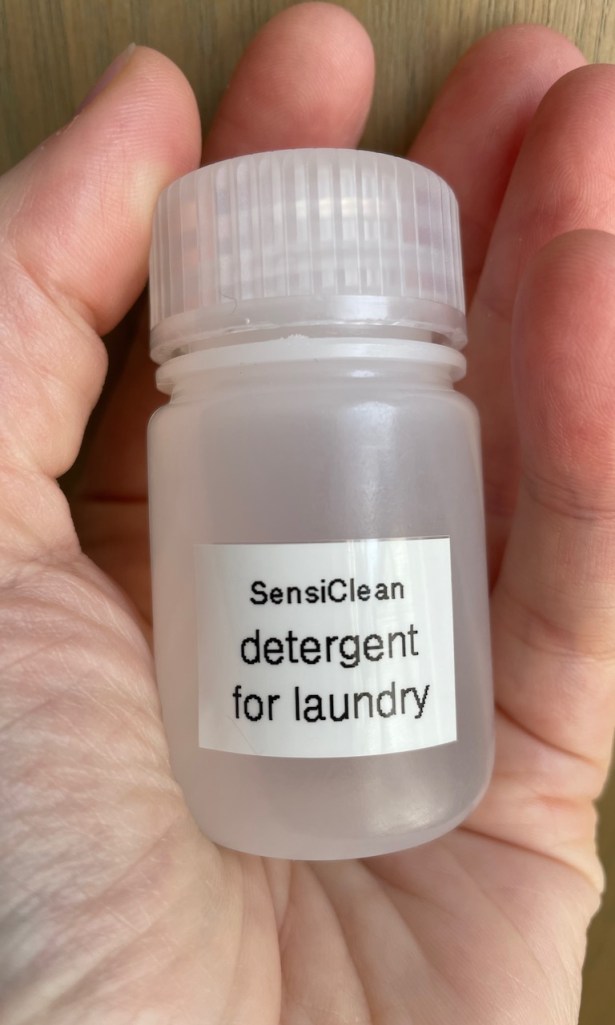
For an upcoming multi-week trip, I’ll carry a small 1 oz bottle of SensiClean liquid detergent for occasional hand washing of delicate items.
My all-time-favorite cruise purchase is an unlimited wash-dry-and-fold package, but there are expensive delicates I won’t send to an industrial laundry unless I’m too sick to take care of them myself. For those, and in case my child’s eczema flares due to the ship’s laundry regimen, I’ll have a manual option to detox the layers he wears next to his sensitive skin.
If I were heading to a vacation rental with its own laundry machines, I would pack a roughly 1 cup/250 mL size plastic storage container of Charlie’s Soap for a stay of up to one month. A full load takes less than 1 Tbsp or ≅15 g of this highly concentrated detergent.
An added benefit is that, by storing concentrated, High Efficiency HE detergents in smaller containers after buying them in bulk, my family wastes less of them at home, too. The mere appearance of an industrial size jug seems to prompt people to take larger portions of everything.
For home use, I store a combination of Charlie’s Soap and Charlie’s Laundry Booster pre-mixed in a Lock & Lock HPL807 container that holds 1/2 a quart or 2 cups of powdered detergent. This will last two weeks for a family washing one load of laundry per day.
Fels-Naphtha laundry bar
If you don’t already have laundry detergent at home and you want to purchase one easy-to-travel-with product, consider a Fels-Naptha Laundry Bar & Stain Remover stick. It’s like bar soap, but for your clothes.
Though it’s often tucked away on the top or bottom shelf, I routinely find Fels-Naptha at local grocery and general merchandise stores in the laundry aisle. Amazon sells it, but mostly at a grossly inflated price or in large quantities since it is such a low cost item. At Walmart, it is listed for $1.20 as of July 2022 which is about what I’ve paid at a neighborhood shop.
The Fels-Naptha bar dates back to the 1890’s, though modern versions no longer contain toxic naphtha, a flammable carcinogen that was especially popular in cleaning products during the Great Depression.
Essentially a giant bar of soap/detergent in a paper wrapper, Fels-Naphtha can be carried on a trip by plane without the special handling required for liquids.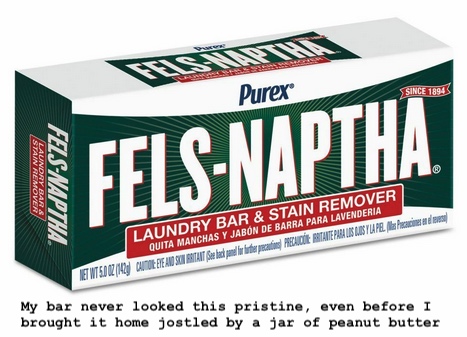
One of my kids has always claimed that Fels-Naptha looks delicious. It would be best to keep it—and all other cleaning products—well away from children too young or too silly to heed safety warnings.
Scanned directly from the package, below are the directions for use and ingredients printed on the wrapper for my perhaps ten year old bar of Fels-Naptha. One bar will last a very long time when used as a stain/spot pre-treatment!
Directions for Fels-Naptha
Stain Pre-treater:
- Wet stain, then rub with bar
- Wait 1 minute and wash as normal
Laundry Booster:
- Grate 1/16th into washer with detergent
- Wash as normal
Ingredients for (Modern) Fels-Naptha:
SOAP (SODIUM ALLOWATE* SODIUM COCOATE® (OR) SODIUM PALMATE KERNELATE: AND SODIUM PALMATE). WATER, TALC, DIPENTENE, COCONUT ACID*. PALM ACID*, TALLOW ACID* PEG- METHYL ETHER, GLYCERIN, SODIUM CHLORIDE, PENTASODIUM PENTETATE AND/OR TEIRASODIUM TIDRONATE, TITANIUM DIOXIDE, TRICLOCARBAN, FRAGRANCE, ACID ORANGE 24. ACID YELLOW 73 *CONTAINS ONE OR MORE OF THESE INGREDIENTS
Like most detergents, you should avoid getting Fels-Naptha directly in your eyes or otherwise prolonging skin contact.
The Fels-Naptha bar was one of the first laundry products I taught my kids to use by themselves. Because you just wet the fabric with the stain then rub the wet spot with the bar, my kids were expected to rub some onto any grass stains on their knees when they came home from school. By the upper elementary grades, they did this unsupervised.
Because of endemic Lyme disease in our area and our primary school’s emphasis on time spent outdoors, my kids did a tick check and changed clothes immediately after getting home from grade school. There were a lot of grass stained knees during those years.
My Fels-Naptha bar has one end of the wrapper torn off and lives in a tattered Ziploc sandwich bag under the bathroom sink. Though I’m exquisitely sensitive to fragrance and one of my kids has severe eczema, I’ve never observed an adverse reaction triggered by Fels-Naptha as a spot treatment, not even when the eczema-prone kid spot-treats his own clothes.
I did teach my kids to hold the bar through the plastic baggie, though, and to wash their hands after handling it or any other cleaning products.
For an upcoming trip, I finally tried something I’ve been meaning to do for a while: I cut off about an inch of Fels-Naptha from my big bar with a kitchen knife so I could pack the smaller sliver. It wasn’t the tidiest operation ever, but my arthritic hands managed the job, and now I have a perfect stain stick to pack for travel.
I saved the Fels-Naptha shards created by hacking away with a serrated knife. As indicated in the directions above, grated Fels-Naptha works as a laundry booster/additive. I dropped those bits of detergent in my front loader and used a bit less soap than normal in my next load of towels.
I can’t say for certain whether Fels-Naptha works better or worse than my mother’s old standby of Spray & Wash or the Shout Stain Removing Gel I use myself when pre-treating laundry right before putting it in the washer. The truth is, I wasn’t going to chase my kids every day after school looking for dirty spots, and the Fels-Naptha was the only product I felt comfortable letting them use on their own.
It was less that I feared a Spray & Wash injury, and more because I could imagine a mess if that liquid spilled, or if over-spray damaged a delicate item sitting nearby. My Shout Gel doesn’t have bleach in it, but it does warn about the potential to discolor khakis or brights, so passing it to the wee punks seemed like a bad idea.
Most families could make use of a Fels-Naptha bar for stains, and I find it much longer lasting and less likely to make a mess than other spot cleaning solutions. The Tide Pen form factor is great, but I’ve found those dry out or get lost before I use them up, and they cost more per pen than an entire bar of Fels-Naptha.
With the bar carved down to a small piece, I’ve got a travel sized stain stick that won’t leak, won’t irritate my family’s skin, and fits in the palm of my hand.
Reisetube detergent may be familiar to European shoppers
On a laundry forum once—and, yes, now we all know I’m the kind of slob who has the gall to visit laundry forums!—I read about a product one lady picked up every time she want to Europe: detergent in a Reisetube.
The next time I passed through Germany, I bought some for myself. The brand I found was Burti Waschmittel Reisetube. This particular product is vegan.
My reisetube was inexpensive in a supermarket, but it isn’t obviously available in the USA so far as I can tell; Amazon.de has it. On Amazon.com, I found a similar product, Rei in der Tube which is also a German import. At $9 for only 30 mL, however, it strikes me as too expensive, and disposable tubes are inherently hard to refill, thus generating a lot of garbage if used often
It must be said that, aside from the environmental impact, this may be a perfect form factor for travel detergent. Gel seems more soluble in hard water than powder. Unlike liquid in a jug or bottle, gel also seems less likely to leak or drip out of its tube in transit.
My Burti Waschmittel Reisetube has a very slight scent, but it doesn’t bother me after my garments dry. I have not used this on my eczema prone child’s clothing enough to have an opinion as to whether it irritates his skin. I’ve found that most German detergents I try work very well, but have more fragrance added than I’m happy with.
What most people call perfume, I describe as “stink.”
As with a Fels-Naptha bar, a reisetube might be the best single purchase for a traveler who doesn’t stock a home laundry room with products to refill personal containers.
Final verdict on best travel laundry form factor for most
The best option for most travelers is packing one’s own usual preferred detergent in reusable containers. Unless you live in an area with exceptionally hard or soft water, actually necessitating a change when visiting places with different conditions, you’ve likely gone through the trial and error to find the best cleaning products for your own use.
You know what you like; you’ll probably prefer the same product on vacation or away from home on business.
People with a cupboard full of Tupperware or other lidded containers may well already have exactly the right size on hand to fill with detergent for longer trips. Those who travel often should probably invest in a few small Nalgene bottles or tubs to dedicate to liquid or powder detergent.
Another important piece of advice: an unlabeled container leads to waste, in my experience. No matter how convinced I am that I’ll recall what’s inside each bottle, I end up forgetting, sometimes discarding a product because I’m no longer certain what it is or how old it is. Even Scotch tape works; for best results, label everything immediately after filling!
Travelers who don’t do their own laundry at home would do best to purchase either a Fels-Naptha bar or a reisetube to carry on trips, depending upon whether s/he often encounters liquid restrictions at TSA checkpoints. The former is slightly better for spot treatment; the latter is easier to use in a hotel room sink for hand washing delicates.
♦
*I like Stasher brand bags, especially the Stand Up- Mini and -Mid for travel, but they’re too thick to individually wrap separate bottles as I prefer for certain particularly messy liquids. I do wash and re-use disposable Ziploc bags for travel, however, and I would absolutely use a Stand Up Mini to store detergent by my washing machine at home for long term use.
†SensiClean is also sold under the name SportWash. The maker is Atsko. I have purchased these products direct as well as from Amazon and sporting goods stores.
SportWash is available in more sizes than SensiClean, but both are “residue free” detergents. That benefits people with sensitive skin, but also hunters who have learned that common household products leave them with a distinctly unnatural chemical odor that chases their prey away.
‡I label mine with my beloved Brother P-touch PT-1400, but tape and a Sharpie work almost as well if you aren’t being graded on neatness. Standard TZ Tape labels compatible with P-touch printers last through at least a few dishwashing cycles in my experience; Extra Strength Adhesive Tape TZ Tapes persevere even longer.
If buying a label maker for the first time, I suggest selecting a model that can use tapes at least 1 inch wide. I picked up a different Brother model at Costco as a gift for my mother years ago, and both of us experienced a lot of annoyance that hers could only use the narrower 1/2 inch TZ Tapes.
 Put simply, a single shot now offers two kinds viral defense: more of the same protection from the original booster, plus, for the first time, the specific power to fight Omicron. That named strain of the virus, also known as lineage B.1.1.529, caused the enormous spike in coronavirus cases early in 2022. It’s estimated that the “mild” Omicron strain was responsible for killing 117,560 people in America. Source: MedRxiv.
Put simply, a single shot now offers two kinds viral defense: more of the same protection from the original booster, plus, for the first time, the specific power to fight Omicron. That named strain of the virus, also known as lineage B.1.1.529, caused the enormous spike in coronavirus cases early in 2022. It’s estimated that the “mild” Omicron strain was responsible for killing 117,560 people in America. Source: MedRxiv.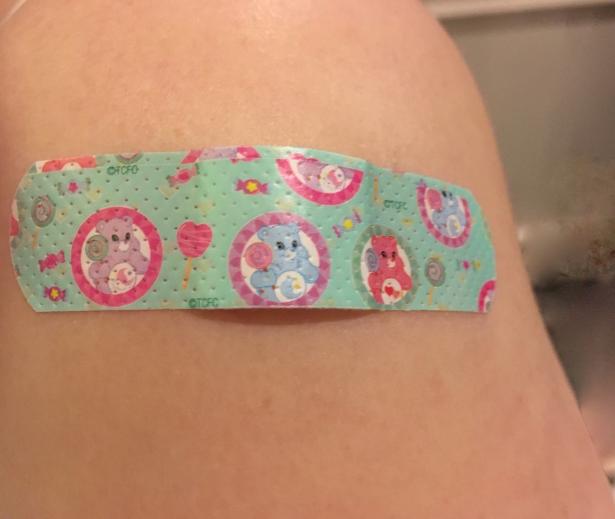 The most impressive technology can solve no problem if it isn’t deployed where it is needed and at the right time. Safe, modern, effective vaccine boosters against COVID are being provided at no cost by the U.S. government. Those shots are available today.
The most impressive technology can solve no problem if it isn’t deployed where it is needed and at the right time. Safe, modern, effective vaccine boosters against COVID are being provided at no cost by the U.S. government. Those shots are available today.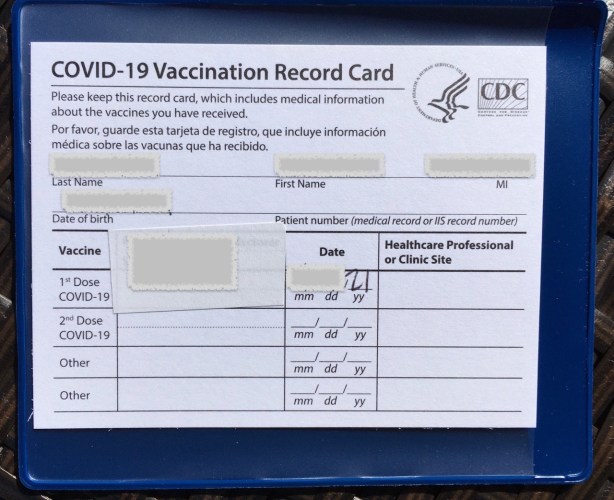






 Why do I have a travel size bottle of The Laundress Signature Detergent, then, if I don’t care for it and it is so expensive? I received a mini set of their products as a gift-with-purchase, probably of closet organizers…
Why do I have a travel size bottle of The Laundress Signature Detergent, then, if I don’t care for it and it is so expensive? I received a mini set of their products as a gift-with-purchase, probably of closet organizers…














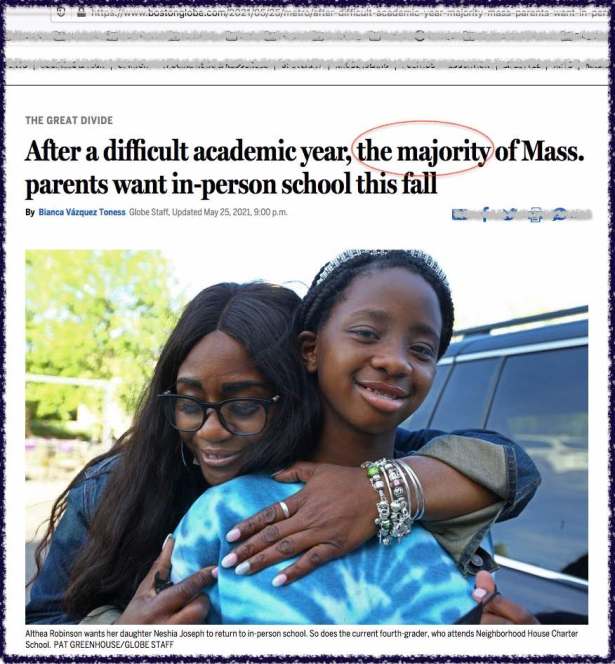 That unambiguous headline hides the whopping 31% of parents who disagreed with the sentiment. Almost a third of the
That unambiguous headline hides the whopping 31% of parents who disagreed with the sentiment. Almost a third of the 


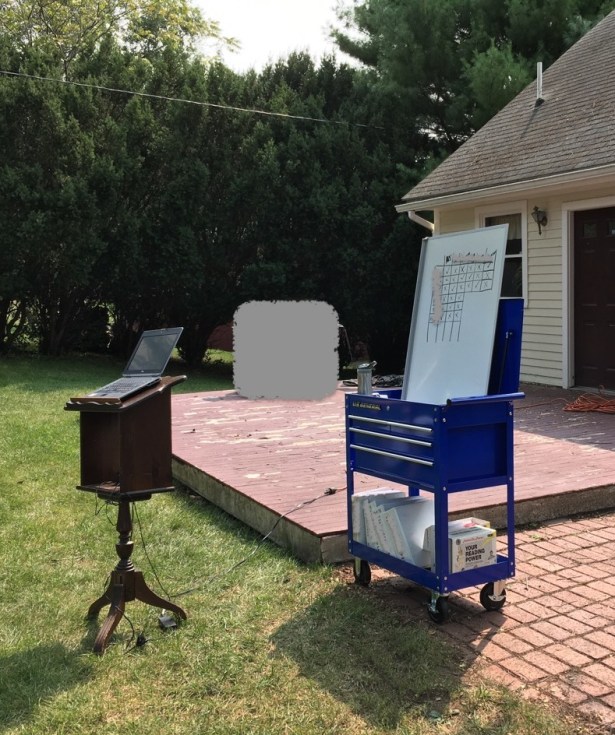 My child requested a return to in person school, and we agreed that he may go until they move indoors with the caveat that any surge in local virus outbreaks or lax enforcement of health protocols at school could change our position.
My child requested a return to in person school, and we agreed that he may go until they move indoors with the caveat that any surge in local virus outbreaks or lax enforcement of health protocols at school could change our position.
 Watching the children organically form into a whooping, running mass as they re-accustomed themselves to being together was one of the most heart-lifting things I’ve seen since the pandemic began. These kids are thrilled to be in each other’s company again, and the joy of play was plain on every covered face. I felt terrible each time I had to interrupt a game to remind a kid that his mask was slipping.
Watching the children organically form into a whooping, running mass as they re-accustomed themselves to being together was one of the most heart-lifting things I’ve seen since the pandemic began. These kids are thrilled to be in each other’s company again, and the joy of play was plain on every covered face. I felt terrible each time I had to interrupt a game to remind a kid that his mask was slipping. Try to get your kid to jog around the block in a new mask before sending her with it to “in person” school. A kid with a mask that doesn’t fit well—or feel comfortable—is being set up for discipline and failure. There are many mask styles available now, so keep looking until you find one your child can tolerate.
Try to get your kid to jog around the block in a new mask before sending her with it to “in person” school. A kid with a mask that doesn’t fit well—or feel comfortable—is being set up for discipline and failure. There are many mask styles available now, so keep looking until you find one your child can tolerate.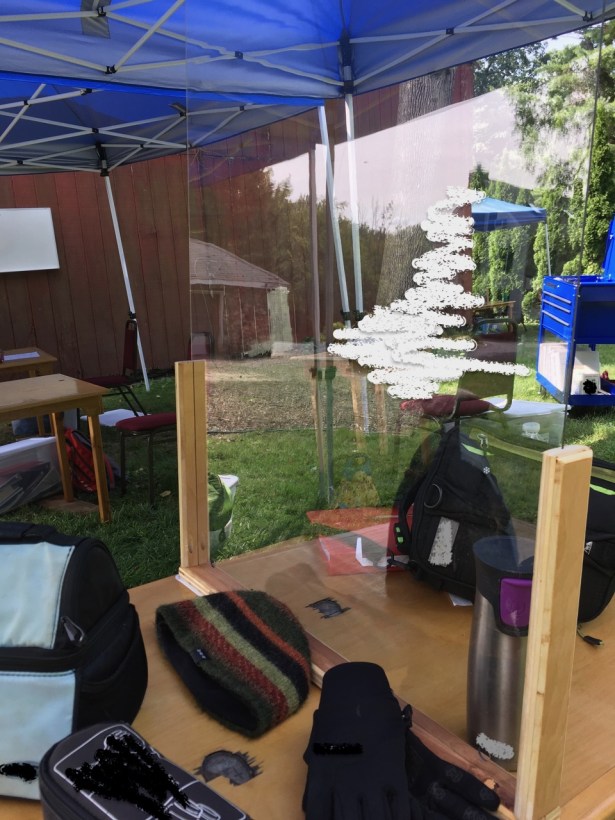
 On a fine September morning, tents nestled alongside a red-painted barn appear positively idyllic. School started with each child finding his desk ready for him, each with a personal bin for books and papers. The same fellow had to source and procure these new materials after doing the planning to figure out what was needed and how to pay for it.
On a fine September morning, tents nestled alongside a red-painted barn appear positively idyllic. School started with each child finding his desk ready for him, each with a personal bin for books and papers. The same fellow had to source and procure these new materials after doing the planning to figure out what was needed and how to pay for it.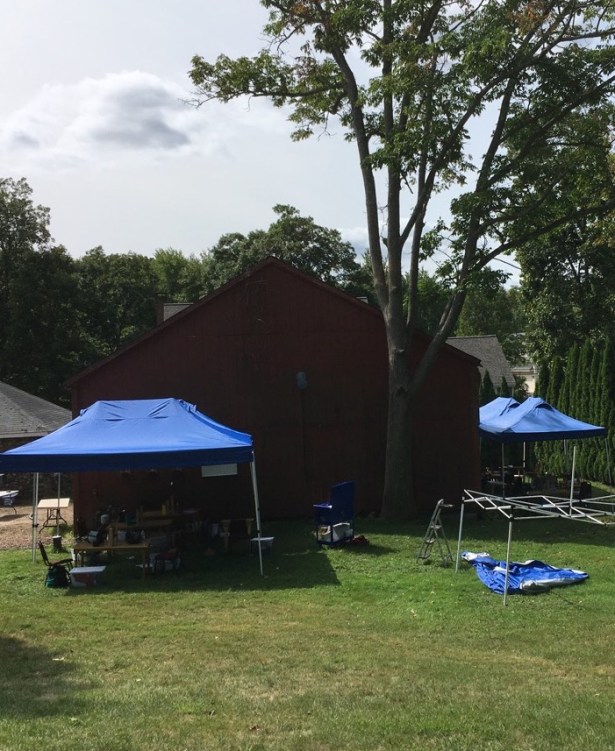 Of course, there is more to weather than rain. When the breeze picked up, kids realized that outdoor classrooms require heavier jackets much earlier in the season.
Of course, there is more to weather than rain. When the breeze picked up, kids realized that outdoor classrooms require heavier jackets much earlier in the season.